Introduction
Wireless local area networks (WLANs) play a pivotal role in connecting wireless devices. Their applications in the 5.8-GHz band have transformed connectivity by supporting more devices and facilitating higher transmission rates [Reference Xu, Liang and Li1]. This is especially significant in the context of fifth- and sixth-generation mobile communications. Specifically, the use of multiple-input multiple-output (MIMO) antenna arrays plays a crucial role in enhancing transmission rates and channel capacity, achieving this without the need for additional spectrum resources or increased transmission power. However, this approach presents challenges in antenna design, especially when dealing with co-frequency and co-polarization antennas that are closely situated within the E- or H-plane. This scenario leads to strong mutual coupling between antenna elements, which in turn can cause issues such as impedance mismatch, distortion in the radiation pattern, and a decrease in realized gain [Reference Guo, Li and Yang2, Reference Ren, Liu and Sim3]. Therefore, enhancing isolation is a crucial aspect for designing WLAN-MIMO antennas [Reference Kumar and Imaculate Rosaline4–Reference Wong, Chen and Li8].
Recently, several scholars proposed various decoupling methods to address the problem of strong mutual coupling between MIMO antenna elements. Based on the origin of the coupling waves, the techniques for minimizing coupling can be categorized into two main types: (i) direct suppression, which includes methods such as utilizing defected ground structures (DGSs) [Reference Gao, Cao and Fu9, Reference Qian, Chen and Kishk10], electromagnetic (EM) bandgap structures [Reference Tan, Wang and Wu11], and metasurfaces/metamaterials [Reference Luan, Chen and Chen12, Reference Jafargholi, Jafargholi and Choi13]. These are employed to mitigate the coupling of floor currents, surface currents, and space waves, respectively; (ii) cancellation schemes, where the original coupling field is counteracted by a field produced through a decoupling structure. Common structures include the neutralization line [Reference Liu, An and Zheng14], decoupling network [Reference Li, Wang and Jiang15, Reference Li, Zhang and Wu16], polarization-conversion isolator [Reference Cheng, Ding and Shao17–Reference Odabasi, Salimitorkamani and Turan19], and parasitic elements [Reference Song, Zhu and Wang20, Reference Abbasi, Aziz and Malik21]. Additionally, recently received considerable attention, the self-decoupling method can be classified as a cancellation type. Distinguished from other traditional decoupling methods, the self-decoupling method makes use of the advantageous features of the antenna itself to reduce mutual coupling between MIMO antenna elements, without the necessity for additional decoupling structures [Reference Lin, Chen and Ji22–Reference Lai, Pan and Zheng25]. For example, Lin et al. [Reference Lin, Chen and Ji22] engineered a microstrip patch antenna (MPA) using an inset-fed design. When the geometric parameters of the feeding structure are optimally configured, the fields generated by the feeding structure and radiation patch counteract each other. This creates a region of weak field on the ground plane. By positioning the antenna elements within this weak-field area of the adjacent elements, high isolation between MIMO antenna elements is realized, eliminating the need for a separate decoupling structure. A similar study, as reported in paper [Reference Lai, Pan and Zheng23], involved the simultaneous excitation of TM10 and TM02 modes in a patch antenna. By fine-tuning the frequency of these two modes, the electric fields (E-fields) coupled to an unexcited patch antenna counteract each other, resulting in a distinct null-field region. As highlighted in prior research, while traditional decoupling schemes are effective in enhancing isolation to approximately 20 dB or more, they exhibit several drawbacks, such as increased physical profile [Reference Luan, Chen and Chen12, Reference Jafargholi, Jafargholi and Choi13], complex antenna structure [Reference Cheng, Ding and Shao17, Reference Wei, Li and Wang18], and compromised matching, and radiation performance. Simultaneously, the self-decoupling scheme, despite attracting significant research interest, presents its own challenges, for example, (i) the challenge in exciting or introducing the required mode and (ii) different arrangements of antenna elements and the method of weak-field generation leading to limitations in practical applications.
Furthermore, previous studies suggest that most decoupling methods are suitable for narrowband MIMO antennas. Therefore, the coupling suppression of broadband MIMO antennas has attracted the attention of numerous researchers [Reference Tran, Hussain and Park26–Reference Tian and Du28]. In MPA, the methods commonly used to improve bandwidth include loading parasitic elements [Reference Tran, Hussain and Park26, Reference Chang and Liu29], multimode technology [Reference Yuan, Chen and Gu27, Reference Liu, Zhu and Zhang30], and introducing metasurfaces [Reference Qiu, Weng and Hou31]. Tran et al. [Reference Tran, Hussain and Park26] reported that by introducing parasitic elements, the bandwidth of an MIMO antenna was improved by approximately 4.8%, and the isolation was improved to more than 30 dB. Yuan et al. [Reference Yuan, Chen and Gu27] proposed a planar inverted-F MIMO antenna that operates with a wide bandwidth of 78% using the multimode technology.
In general, in a rectangular MPA array, the field distributions of the excited antenna and coupled antenna element are in the TM10 mode. This study proposes a polarization conversion parasitic structure (PCPS), which can convert the x-polarized TM10 mode of the coupled E-field to the y-polarized TM01 mode. Consequently, the coupled fields of the two orthogonal modes cancel each other in the adjacent passive unexcited MPA, resulting in a specific weak-field region. The results show that when the feed probe of the unexcited MPA is intentionally placed in the weak-field region, the unexcited MPA cannot be excited effectively, and a low mutual coupling of approximately −49 dB can be obtained at 5.8 GHz. The effect of the decoupling structure on antenna performance is small and can thus be applied to multielement MIMO antenna arrays.
Design and analysis of polarization converter parasitic structure
In this section, the design and analysis of the proposed rectangular-ring PCPS are described. The structure of a PCPS is shown in Fig. 1(a). A rectangular metallic ring, tilted at 45° with respect to the x-axis, was mounted on top of an FR-4 substrate. This substrate exhibited a relative permittivity of 4.3 and a thickness of 1.6 mm. Below it, a metallic ground plane was established as the base layer. The simulation of this arrangement was conducted using CST Microwave Studio Software, setting up boundary conditions in the Floquet port. To determine the characteristics of an infinite periodic structure, its unit cells were simulated. The incident E-field was aligned with the z-axis. The parameters of the unit cell, set as W d = 18 mm, L r = 10 mm, and W r = 5 mm, were carefully selected to align the operating bandwidth of the proposed rectangular-ring PCPS with that of the antenna.

Figure 1. Structures and simulated results of rectangular ring PCPS. (a) Top and side view. (b) Co- and cross-polarization coefficients and PCR.
Consider the normal incident y-polarized EM wave as an example, denoted as ![]() $E_y^i$. The reflection coefficient and polarization conversion ratio (PCR) of the rectangular-ring PCPS are illustrated in Fig. 1(b). The reflected EM wave comprises co-polarized (ryy) and cross-polarized (rxy) reflections, defined as
$E_y^i$. The reflection coefficient and polarization conversion ratio (PCR) of the rectangular-ring PCPS are illustrated in Fig. 1(b). The reflected EM wave comprises co-polarized (ryy) and cross-polarized (rxy) reflections, defined as  ${r_{yy}} = \left| {\vec E_y^r} \right|/\left| {\vec E_y^i} \right|$ and
${r_{yy}} = \left| {\vec E_y^r} \right|/\left| {\vec E_y^i} \right|$ and  ${r_{xy}} = \left| {\vec E_x^r} \right|/\left| {\vec E_x^i} \right|$, respectively. Given that the rectangular ring is symmetrical in y- and x-directions, the simulated results of x-polarized incident EM waves are the same as those of y-polarized EM waves. Figure 1(b) illustrates that ryy values are less than −10 dB while those of rxy were approximately 0 dB in the range of 5.6–6.3 GHz. Furthermore, PCR indicates the polarization conversion efficiency, which can be expressed as follows [Reference Zheng, Guo and Ding32]:
${r_{xy}} = \left| {\vec E_x^r} \right|/\left| {\vec E_x^i} \right|$, respectively. Given that the rectangular ring is symmetrical in y- and x-directions, the simulated results of x-polarized incident EM waves are the same as those of y-polarized EM waves. Figure 1(b) illustrates that ryy values are less than −10 dB while those of rxy were approximately 0 dB in the range of 5.6–6.3 GHz. Furthermore, PCR indicates the polarization conversion efficiency, which can be expressed as follows [Reference Zheng, Guo and Ding32]:
 \begin{equation}PCR = {\left| {{r_{xy}}} \right|^2}/\left( {{{\left| {{r_{yy}}} \right|}^2} + {{\left| {{r_{xy}}} \right|}^2}} \right)\end{equation}
\begin{equation}PCR = {\left| {{r_{xy}}} \right|^2}/\left( {{{\left| {{r_{yy}}} \right|}^2} + {{\left| {{r_{xy}}} \right|}^2}} \right)\end{equation}where ryy and rxy are obtained from Fig. 1(b). Meanwhile, effective polarization conversion is realized, as shown in Fig. 1(b), due to the PCR value, which is approximately 100% at 5.8 GHz.
To understand the operating principle of the rectangular metal ring, the induced current distributions of the rectangular ring element when the normal incident wave is y-polarized are shown in Fig. 2(a). The opposite induced current was excited on the rectangular metal ring and floor, indicating that the magnetic resonance was generated at 5.8 GHz. Furthermore, Fig. 2(b) shows that the induced magnetic field ![]() ${\vec H^r}$ along the lower right direction decomposes into two orthogonal components
${\vec H^r}$ along the lower right direction decomposes into two orthogonal components ![]() $\vec H_x^r$ and
$\vec H_x^r$ and ![]() $\vec H_y^r$ along x- and y-axes, respectively. The component
$\vec H_y^r$ along x- and y-axes, respectively. The component ![]() $\vec H_x^r$ is perpendicular to the incident E-field
$\vec H_x^r$ is perpendicular to the incident E-field ![]() $\vec E_y^i$, with no cross-coupling between the induced magnetic field and induced E-field. Thus, component
$\vec E_y^i$, with no cross-coupling between the induced magnetic field and induced E-field. Thus, component ![]() $\vec H_x^r$ does not contribute to the polarization conversion. Conversely, component
$\vec H_x^r$ does not contribute to the polarization conversion. Conversely, component ![]() $\vec H_y^r$ is parallel to the incident electric E-field
$\vec H_y^r$ is parallel to the incident electric E-field ![]() $\vec E_y^i$, which induces an E-field perpendicular to
$\vec E_y^i$, which induces an E-field perpendicular to ![]() $\vec E_y^i$. Consequently, the strong cross-coupling between the induced magnetic field and E-field is generated by
$\vec E_y^i$. Consequently, the strong cross-coupling between the induced magnetic field and E-field is generated by ![]() $\vec H_y^r$, thereby, converting the incident wave from y-polarized to that of the reflection wave in x-polarized. Specifically, the magnetic field component parallel to the incident E-field causes the polarization conversion effect. The proposed rectangular ring can be regarded as a polarization converter in the desired operating bandwidth. Regarding the mechanism for reducing mutual coupling, the directional state of the coupling current is a critical factor in enhancing isolation between antenna elements. Consequently, the properties of PCPS can be leveraged to improve isolation due to their capability to alter the direction of the surface coupling current.
$\vec H_y^r$, thereby, converting the incident wave from y-polarized to that of the reflection wave in x-polarized. Specifically, the magnetic field component parallel to the incident E-field causes the polarization conversion effect. The proposed rectangular ring can be regarded as a polarization converter in the desired operating bandwidth. Regarding the mechanism for reducing mutual coupling, the directional state of the coupling current is a critical factor in enhancing isolation between antenna elements. Consequently, the properties of PCPS can be leveraged to improve isolation due to their capability to alter the direction of the surface coupling current.
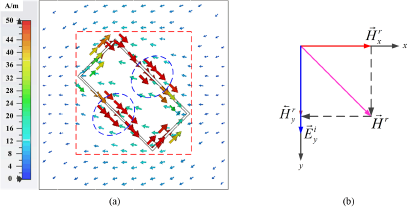
Figure 2. Induced current distribution of rectangular ring PCPS at 5.8 GHz and its decomposition diagram.
Design and analysis of two-element decoupling MPA
In this section, the configuration of a 1 × 2 MIMO MPA array is introduced first. Then, the decoupling mechanism is analyzed in detail.
Design and analysis of the proposed antenna
Figure 3 illustrates the two-element decoupled MIMO MPA structure constructed on an FR-4 substrate with a dielectric constant of 4.3 and an overall size of 41 × 41 × 1.6 mm3. Both MPAs were coaxially fed. The edge-to-edge and center-to-center distances between the two patches were d = 12 mm (![]() $0.23{\lambda _0}$) and d 1 = 22 mm (
$0.23{\lambda _0}$) and d 1 = 22 mm (![]() $0.42{\lambda _0}$), respectively, where
$0.42{\lambda _0}$), respectively, where ![]() ${\lambda _0}$ denotes the wavelength in free space at a resonant frequency of 5.8 GHz. The proposed decoupling structure comprises three rectangular ring PCPSs arranged along the y-axis. According to the analysis described in the previous section, the decoupling structure can convert the polarization mode of the coupled E-field from the x-polarized TM10 mode to the y-polarized TM01 mode. Thus, mode cancellation was realized on the coupled antenna. Detailed parameters of the decoupling structure are as follows: W g = L g = 41 mm, W = 10 mm, W 1 = 2.7 mm, L = 13 mm, L 1 = 6.5 mm, L 2 = 4 mm, d = 12 mm, and h = 1.6 mm.
${\lambda _0}$ denotes the wavelength in free space at a resonant frequency of 5.8 GHz. The proposed decoupling structure comprises three rectangular ring PCPSs arranged along the y-axis. According to the analysis described in the previous section, the decoupling structure can convert the polarization mode of the coupled E-field from the x-polarized TM10 mode to the y-polarized TM01 mode. Thus, mode cancellation was realized on the coupled antenna. Detailed parameters of the decoupling structure are as follows: W g = L g = 41 mm, W = 10 mm, W 1 = 2.7 mm, L = 13 mm, L 1 = 6.5 mm, L 2 = 4 mm, d = 12 mm, and h = 1.6 mm.

Figure 3. Structures of the proposed MIMO antenna.
The aforementioned MIMO antenna is simulated and optimized using CST software to evaluate its radiation and isolation performance, with the simulated S-parameters displayed in Fig. 4. The reference antenna (without PCPS) demonstrated good matching, with the reflection coefficient surpassing 10 dB. In comparison, the isolation at 5.8 GHz was only approximately 12 dB. Upon introducing rectangular-ring PCPSs vertically between the antennas, the simulation results indicated that the PCPSs significantly contribute to suppressing mutual coupling in the MIMO antenna system. The highest isolation achieved was 49 dB at 5.8 GHz, while S11 was at −24 dB. Additionally, there was a slight reduction in the operating bandwidth of the antenna. This occurs because the decoupling structure closely resembles the reference antennas, and they all share the same substrate. EM radiation from the antenna can easily couple within the substrate, leading to a balance between the radiation performance and isolation performance of the antenna.

Figure 4. Simulated S-parameters of the proposed MIMO antenna.
Decoupling mechanism
The operating mechanism of the decoupling effect due to the rectangular-ring PCPS can be presented by observing the surface current and E-field distributions of the proposed antenna at 5.8 GHz. In the following analysis, only Ant_1 was excited whereas Ant_2 was connected to a 50-Ω matched load.
Figure 5(a) shows the surface current distributions of the proposed antenna at 5.8 GHz, prior to the integration of rectangular-ring PCPSs. When Ant_1 was activated, it induced a coupling current in Ant_2, moving in the same direction along the x-axis. Conversely, Fig. 5(b) shows that after adding PCPSs to the MIMO antenna, the coupling current Ant_2 adopts an orthogonal direction when compared to its initial distribution. This change shifts the reciprocating movement of the coupling current from the x-axis to the y-axis for Ant_2, significantly reducing the coupling current it receives. Furthermore, while various types of coupling, such as surface wave, near-field, and far-field coupling exist in MPA arrays, surface wave coupling is the predominant form when the substrate’s electrical thickness meets certain criteria [Reference Nikolic, Djordjevic and Nehorai33]:
 \begin{equation}\frac{h}{{{\lambda _0}}} \geqslant \frac{{0.3}}{{2\pi \sqrt {{\varepsilon _r}} }}\end{equation}
\begin{equation}\frac{h}{{{\lambda _0}}} \geqslant \frac{{0.3}}{{2\pi \sqrt {{\varepsilon _r}} }}\end{equation}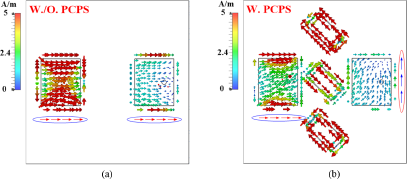
Figure 5. Simulated surface current distributions of the proposed MIMO antenna at 5.8 GHz. (a) Without and (b) with PCPS.
where h and ![]() ${\varepsilon _r}$ denote the thickness and relative permittivity of the substrate, respectively;
${\varepsilon _r}$ denote the thickness and relative permittivity of the substrate, respectively; ![]() ${\lambda _0}$ denotes the wavelength in free space.
${\lambda _0}$ denotes the wavelength in free space.
Figure 6 further illustrates the E-field distribution of the antenna at 5.8 GHz, reinforcing the effectiveness of the proposed decoupling structure. In Fig. 6(a), the reference MIMO antenna shows strong E-fields on the left and right sides, but these fields are considerably weaker in the center. This pattern indicates that Ant_1 is functioning in the TM10 mode. A similar E-field distribution is observed in the coupled, passive Ant_2. However, in Fig. 6(b), with the inclusion of the PCPS decoupling structure, the structure’s capacity to transform the coupling E-field from x-polarization TM10 mode to y-polarization TM01 mode becomes apparent. Hence, Ant_2 receives simultaneous coupling from the TM10 mode of Ant_1 and TM01 mode of the decoupling structure. This coupling leads to the E-fields of the two modes in passive Ant_2 neutralizing each other, thereby creating an area of weak field. Consequently, when the feed position of passive Ant_2 is located in this weak-field area, it is less effectively excited due to reduced port energy, resulting in a significant decrease in mutual coupling to −49 dB.

Figure 6. Simulated E-field distribution of the reference and proposed MIMO MPA array at 5.8 GHz. (a) Without PCPS. (b) With PCPS. (c) TM10 mode. (d) TM10 mode. (e) TM10 mode. (f) TM01 mode. (g) TM10 and TM10 modes.
Figures 6(c–g) depict the development of a weak-field region in MPA-2, a key aspect of the proposed self-decoupling method. Figure 6(e) illustrates that, when operating exclusively in the TM10 mode, the E-fields on the left and right sides of the patch antenna are in opposing directions. Similarly, Fig. 6(f) demonstrates that when functioning solely in the TM10 mode, the E-fields at the top and bottom of the patch are also opposite. In the designed MIMO antenna, both TM10 and TM01 modes are simultaneously coupled to Ant_2. Figure 6(g) shows that the intersection of these opposing fields leads to a significant weakening of the field intensity in certain areas, resulting in the formation of a weak-field region.
Fabrication and measured results
In this section, to verify the feasibility, a prototype of the proposed 1 × 2 MIMO MPA array is fabricated and measured. In the following subsections, analysis and discussions on the key parameters are presented.
S-parameters
A photograph of the prototype MIMO antenna, together with the simulated and measured S-parameter results, is shown in Fig. 7. As expected, the S-parameter simulation shown in Fig. 7(a) is consistent with the measured results, and the center frequency of the MIMO antenna approximately corresponds to 5.8 GHz. The operating bandwidth is ![]() $\left| {{{\text{S}}_{{\text{11}}}}} \right|{\text{ \lt - 10 dB}}$ in the range of 5.65–5.9 GHz. Simultaneously, the isolation was greater than 15 dB in the operating bandwidth, and the maximum port isolation at the resonant frequency was 49 dB. Additionally, the frequency deviation was primarily due to the inaccurate dielectric constant of the substrate.
$\left| {{{\text{S}}_{{\text{11}}}}} \right|{\text{ \lt - 10 dB}}$ in the range of 5.65–5.9 GHz. Simultaneously, the isolation was greater than 15 dB in the operating bandwidth, and the maximum port isolation at the resonant frequency was 49 dB. Additionally, the frequency deviation was primarily due to the inaccurate dielectric constant of the substrate.
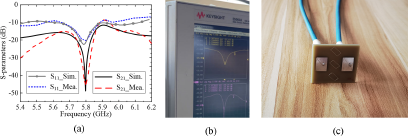
Figure 7. Simulated and measured results of the proposed MIMO MPA array. (a) S-parameters results, (b) S-parameter measurement photos, and (c) photos of the fabricated antenna.
Radiation characteristic
Figure 8 illustrates the simulated and measured radiation patterns of the proposed MIMO antenna at 5.8 GHz in E/H-plane, both with and without the PCPS. The measured results align well with the simulated outcomes, indicating that the PCP decoupling structure does not significantly impact the antenna’s radiation pattern. At 5.8 GHz, the realized gain of the MIMO antenna was observed to be 5.17 dBi. Additionally, the antenna’s cross-polarization was significantly reduced following the decoupling process.

Figure 8. Radiation patterns of the proposed antenna at 5.8 GHz. (a) E-plane and (b) H-plane.
The simulated and measured boresight gains of the proposed 1 × 2 MIMO antenna array are illustrated in Fig. 9, showing that their curves exhibit nearly the same trend in the operating frequency band. Within the operating frequency band of 5.65–5.9 GHz, the measured boresight gain varied between 3.81 and 5.31 dBi, and the maximum and average gain were 5.31 and 4.52 dBi, respectively.
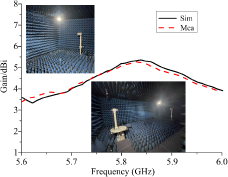
Figure 9. Simulated and measured boresight gains.
MIMO-related performance
The envelope correlation coefficient (ECC) is an important index of an MIMO antenna, and it can be calculated using Equation (3) [Reference Karaboikis, Papamichael and Tsachtsiris34, Reference Khan, Capobianco and Najam35] as follows:
 \begin{equation}ECC = \frac{{{{\left| {\int_0^{2\pi } {\int_0^\pi {\left( {XPR \cdot {E_{\theta i}} \cdot E_{\theta j}^* \cdot {P_\theta } + {E_{\phi i}} \cdot E_{\phi j}^* \cdot {P_\varphi }} \right)d\Omega } } } \right|}^2}}}{{\begin{array}{l}\int_0^{2\pi } \int_0^\pi \left( {XPR \cdot {E_{\theta i}} \cdot E_{\theta i}^* \cdot {P_\theta } + {E_{\phi i}} \cdot E_{\phi i}^* \cdot {P_\phi }} \right)d\Omega \\ \times \int_0^{2\pi } \int_0^\pi {\left( {XPR \cdot {E_{\theta j}} \cdot E_{\theta j}^* \cdot {P_\theta } + {E_{\phi j}} \cdot E_{\phi j}^* \cdot {P_\phi }} \right)d\Omega } \end{array}}}.\end{equation}
\begin{equation}ECC = \frac{{{{\left| {\int_0^{2\pi } {\int_0^\pi {\left( {XPR \cdot {E_{\theta i}} \cdot E_{\theta j}^* \cdot {P_\theta } + {E_{\phi i}} \cdot E_{\phi j}^* \cdot {P_\varphi }} \right)d\Omega } } } \right|}^2}}}{{\begin{array}{l}\int_0^{2\pi } \int_0^\pi \left( {XPR \cdot {E_{\theta i}} \cdot E_{\theta i}^* \cdot {P_\theta } + {E_{\phi i}} \cdot E_{\phi i}^* \cdot {P_\phi }} \right)d\Omega \\ \times \int_0^{2\pi } \int_0^\pi {\left( {XPR \cdot {E_{\theta j}} \cdot E_{\theta j}^* \cdot {P_\theta } + {E_{\phi j}} \cdot E_{\phi j}^* \cdot {P_\phi }} \right)d\Omega } \end{array}}}.\end{equation} \begin{equation}XPR(dB) = 10 \cdot {\log _{10}}\frac{{{P_V}}}{{{P_H}}} \end{equation}
\begin{equation}XPR(dB) = 10 \cdot {\log _{10}}\frac{{{P_V}}}{{{P_H}}} \end{equation} where i and j denote the numbers of ports, XPR denotes the cross-polarization ratio, E denotes the incident electric field, and ![]() ${P_\theta }$ and
${P_\theta }$ and ![]() ${P_\phi }$ denote the θ and φ components of the angular density functions of the incoming wave, respectively, and
${P_\phi }$ denote the θ and φ components of the angular density functions of the incoming wave, respectively, and ![]() $\Omega $ denotes the solid angle of the spherical coordinate.
$\Omega $ denotes the solid angle of the spherical coordinate.
Within the impedance bandwidth of 5.65–5.9 GHz, the ECC of the proposed MIMO antenna was less than 0.025 after loading PCPS, which was much lower than that of the original MIMO antenna (Fig. 10).
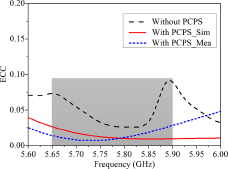
Figure 10. Simulated and measured ECC of the proposed MIMO antenna.
Comparison
Table 1 provides a comparative analysis of the decoupling approaches proposed in this study with those previously reported. Previous studies [Reference Cheng, Ding and Shao17–Reference Odabasi, Salimitorkamani and Turan19] have documented structures capable of generating polarized rotational effects for decoupling purposes. The PCP isolator design in paper [Reference Cheng, Ding and Shao17] was noted for its complexity, requiring multiple optimizations in its connection form. Additionally, the MPA array in paper [Reference Cheng, Ding and Shao17] necessitated the inclusion of circular slots to mitigate the cross-polarized field. Similarly, the implementation of L-shaped stubs was essential in the MPA array of paper [Reference Odabasi, Salimitorkamani and Turan19] for reducing the cross-polarized field. In paper [Reference Wei, Li and Wang18], the spacing between array elements in an MIMO antenna was approximately ![]() $0.53{\lambda _0}$ greater than half the wavelength. Conversely, this study introduces a rectangular-ring polarization–rotation decoupling structure that is not only simpler but also demonstrates a clear decoupling effect without compromising the antenna’s performance.
$0.53{\lambda _0}$ greater than half the wavelength. Conversely, this study introduces a rectangular-ring polarization–rotation decoupling structure that is not only simpler but also demonstrates a clear decoupling effect without compromising the antenna’s performance.
Table 1. Comparison of performance with previously reported antennas
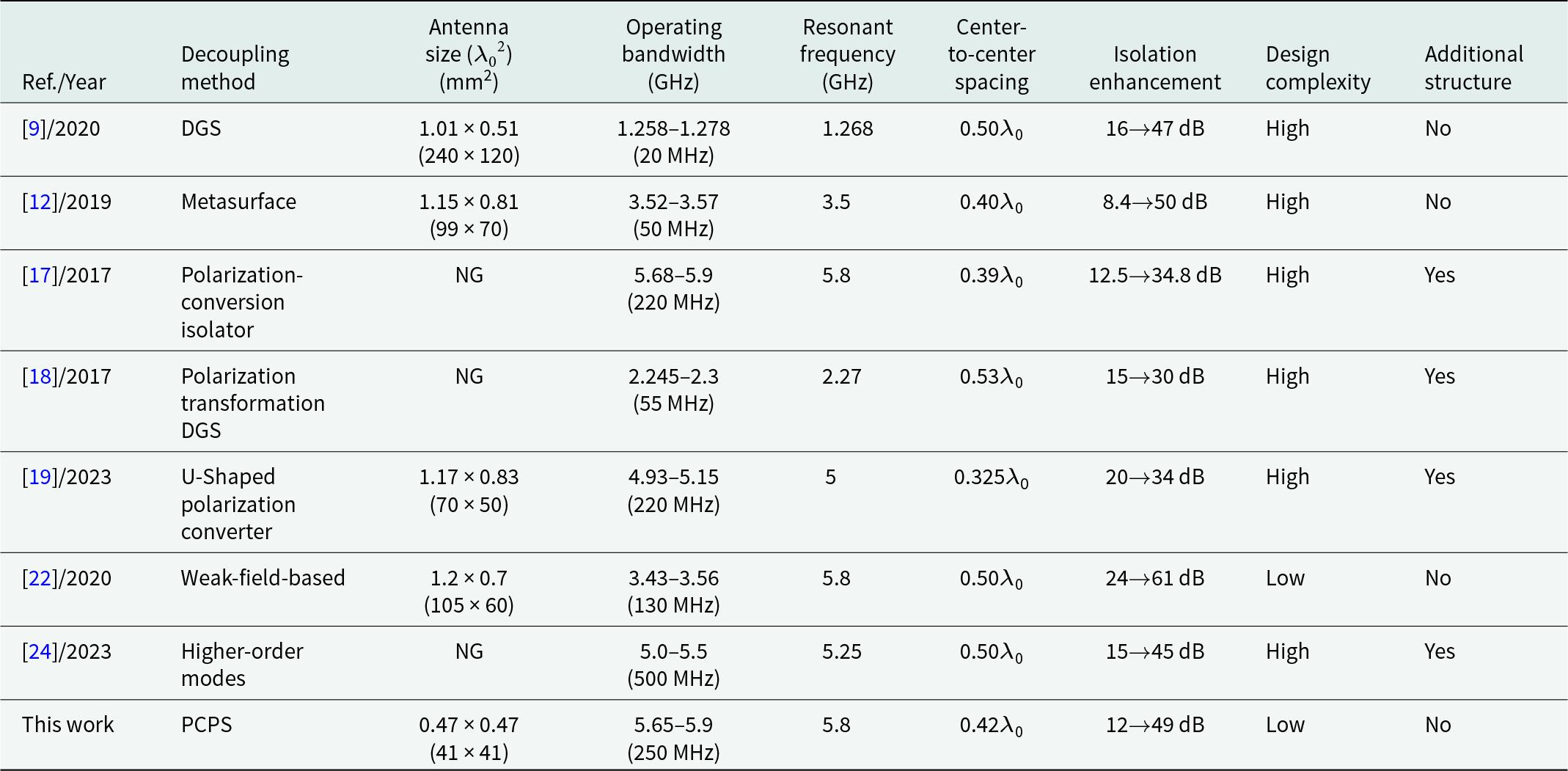
Notes: ![]() ${\lambda _0}$: free-space wavelength at the center frequency. 16→47 indicates that the isolation between the antennas is improved from 16 to 47 dB. NG = not given.
${\lambda _0}$: free-space wavelength at the center frequency. 16→47 indicates that the isolation between the antennas is improved from 16 to 47 dB. NG = not given.
In the case of previous studies [Reference Gao, Cao and Fu9, Reference Luan, Chen and Chen12, Reference Lin, Chen and Ji22, Reference Pan, Hu and Zheng24], although the MIMO arrays realized self-decoupling without using any additional decoupling structure [Reference Lin, Chen and Ji22, Reference Pan, Hu and Zheng24], the method primarily relied on the characteristics of the radiator. Additionally, several defects were observed in these designs. For example, the self-decoupled MPA array reported in paper [Reference Lin, Chen and Ji22] is limited to the specific in-set feed scheme. In contrast, the DRA array reported in paper [Reference Pan, Hu and Zheng24] employs the higher-order mode of DRA, which considerably increases the height (volume) of antenna elements. Meanwhile, the self-decoupling MIMO antenna exhibits the disadvantage of large array element spacing. A metasurface structure is typically placed above the antenna or inserted in the middle of the antenna elements in the loading method. Given that the distance between the metasurface structure and the antenna element significantly affects the isolation performance, the profile height of the antenna increases substantially [Reference Luan, Chen and Chen12].
Conclusions
In this study, a systematic approach is proposed to enhance the isolation between coupled MPA using a rectangular-ring PCP decoupling structure. First, the unit cell of the rectangular-ring PCPS was designed and analyzed independently, and its operating bandwidth was adjusted to match the operating frequency of the reference MIMO antenna. The simulation results demonstrated that the rectangular-ring PCPS efficiently converts the x-polarized E-field into orthogonal y-polarization. Based on this characteristic, a rectangular-ring PCPS was loaded onto a two-element MIMO MPA. Furthermore, TM10 mode from the excited antenna (Ant_1) and TM01 mode from the decoupling structure were concurrently coupled to the passive antenna (Ant_2), forming an evident weak-field region on the passive Ant_2. Therefore, when the feeding position of passive Ant_2 was located in the weak-field region, Ant_2 could not be effectively excited. Hence, extremely low mutual coupling was obtained. Furthermore, the decoupling principle was described in detail based on the distributions of the E-field and surface current before and after antenna decoupling. Finally, the antenna’s performance was measured and compared with those reported in the literature. The comparison shows that the decoupling structure proposed in this study exhibits the advantages of a simple structure, low profile, and no requirements to introduce additional structures to improve the cross-polarization of the antenna. Notably, the concept of polarization conversion is often applied to methods such as radar cross-section reduction and circularly polarized antenna design. This study systematically applied it to the suppression of MIMO antenna array coupling, and thereby, further expanding its application range.
Acknowledgements
This study was supported in part by the Doctoral Innovation Fund of the Xi’an University of Technology under Grant 310-252072219 and in part by the National Natural Science Foundation of China under Grant 62101440.
Competing interests
The authors report no conflict of interest.

Zhonghong Du was born in Tianshui, Gansu, China, in 1994. He received the B.S. in Electronic Information from Xi’an University of Technology, Xi’an, China, in 2017, and M.S. in Communicating Engineering from Xi’an University of Technology, Xi’an, China, in 2020. Where he is currently pursuing the Ph.D. degree in Electromagnetic Field and Microwave Technology. His research interests include MIMO antennas decoupling technology, electromagnetic metasurface, and RF circuits. He serves as a reviewer for the IEEE Antennas and Wireless Propagation Letters, International Journal of Microwave and Wireless Technologies.

Xiaohui Zhang received his B.S. in Industrial Automation in 1995, his M.S. in Control Science and Engineering in 2002, his Ph.D. degree in Control Science and Engineering in 2009, all from Xi’an University of Technology in Xi’an, China. He is currently a professor of Information and Control Department at Xi’an University of Technology, Xi’an, China. His recent research interests include advanced navigation, signal processing and pattern recognition, electromagnetic technology, and antenna design.

Peiyu Qin received her B.S. in Information Engineering from Tianjin Normal University, Tianjin, China, in 2019. She is currently a graduate student at Xi’an University of Technology, Xi’an, China. Currently, she is engaged in research on MIMO antenna coupling suppression and polarization rotation isolation structure at the Department of Electronic and Electrical Engineering, Brunel University, London, United Kingdom.

Yurong Pu received the B.S., M.S., and Ph.D. degrees in Electronic Engineering from the Xi’an University of Technology (XUT), Xi’an, China, in 2004, 2007, and 2013, respectively. She is currently an associate professor with the Department of Electronic Engineering, XUT. Her current research interests include computational electromagnetics and wave propagation.

Xiaoli Xi received her B.S. in Applied Physics from the University of Defense Technology in Changsha, China, in 1990, her M.S. in Biomedical Engineering from the Fourth Military Medical University in Xi’an, China, in 1998, and her Ph.D. degree in Electrical Engineering from the Xi’an Jiaotong University in Xi’an, China, in 2004. She is currently a Professor with the Electronics Engineering Department, Xi’an University of Technology, Xi’an, China. Her current research interests include wave propagation, antenna design, and communication signals processing. She serves as a reviewer for the IEEE Transactions on Microwave Theory and Techniques, IEEE Transactions on Antennas and Propagation, International Journal of Microwave and Wireless Technologies, IET Microwaves Antennas & Propagation, IEEE Access, and IEEE Antennas and Wireless Propagation Letters.














